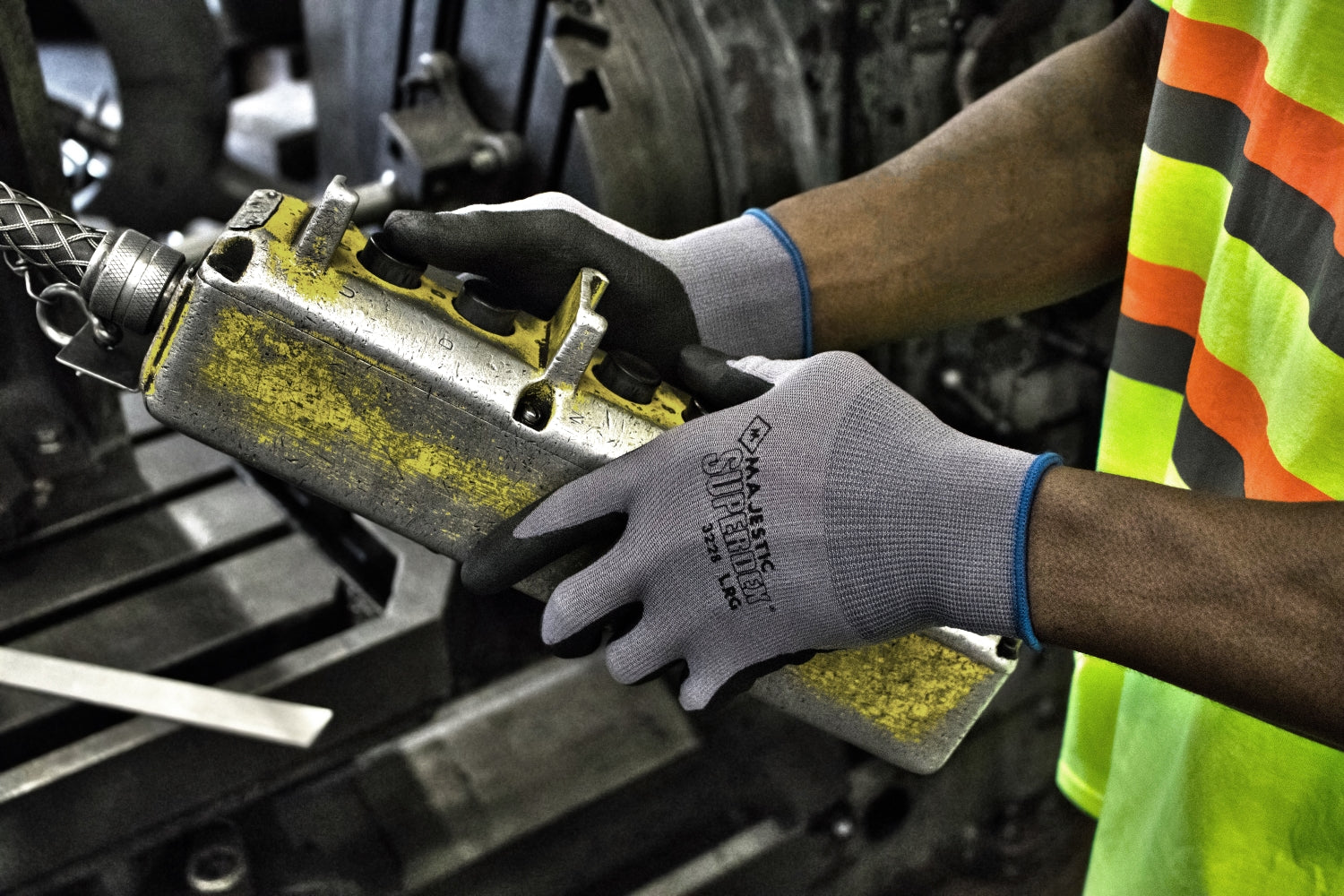
Selecting the right glove for the right job

General Purpose & Palm Coatings
When choosing the right glove, it is important to determine which coating will provide the best protection and proper grip to accomplish your task. A glove’s coating intensifies grip, and increases protection in cut, abrasion, and chemical exposure. Appropriate grip can help prevent hand injuries and improve work performance by reducing hand fatigue, maintaining control, and avoiding slips & drops.
There are many types of gloves available to protect against a wide variety of hazards. The nature of the hazard and the operation performed will influence your selection of gloves.
There does not currently exist one glove that provides protection against all potential hand hazards. It is critical that workers use gloves specifically designed for the hazards and tasks found in their workplace, because gloves designed for one function may not protect against a different function even though they may appear to be an appropriate protective device.
Gloves made from a wide variety of materials are designed for many types of workplace hazards. In general, gloves fall into four groups:
• Gloves made of leather, synthetic fibers or metal mesh
• Fabric and coated fabric gloves
• Chemical protective gloves
• Insulating rubber gloves (for Electrical Protective Equipment)
The following are examples of some factors that may influence the selection of protective gloves for a workplace.
• Type of chemicals handled and toxic properties of the chemicals
• Chemical concentration and temperature (the higher the concentration and temperature, the shorter the breakthrough time)
• Nature of contact (total immersion, continual contact, splash, etc.)
• Duration of contact
• Area requiring protection (hand only, forearm, arm)
• Degree of dexterity
• Grip requirements (dry, wet, oily)
• Thermal protection
• Impact protection
• Size and comfort
• Abrasion and cut resistance requirements
• Other job hazards (such as biological, electrical, and radiation hazards)
General purpose gloves are typically made of fabric or coated fabric. Generally, these gloves are made of cotton, nylon, polyester, or other high-performance material. These gloves protect against dirt, slivers, chafing, and abrasions.
Coating fabric gloves transforms them into general purpose hand protection that offers slip resistant qualities. Any of these gloves can have various coatings on them.
Typical coatings are:
• Polyurethane
• Nitrile including Foam Nitrile, Sandy Nitrile, Micro-Foam Nitrile, and Flat Nitrile
• Latex
• PVC (poly vinyl chloride)
Understanding the properties of each coating is critical when choosing the right glove:
POLYURETHANE
One of the best general purpose, versatile coatings. It is typically very lightweight, soft, breathable, and durable. It provides tremendous dexterity and comfortable grip in multiple applications.
Great for:
• Loading and material handling with high dexterity
• Fastening parts and components along with dismantling
• Surface inspection, chassis assembly, body trimming
Key industries include:
• General maintenance and plant work
• Material handling and fabrication
• Machinery & equipment
• Automotive
MICRO FOAM NITRILE
Provides an excellent grip on wet surfaces, especially oil. The air infused foam nitrile is chemically engineered to create pockets for liquid to be absorbed into the surface and move so the surface stays clear, allowing for a better grip on slippery surfaces. It delivers the best dexterity of the nitrile family of coatings.
Great for:
• Handling metal sheets, coils, tubes & panels
• Inspection, selecting & checking parts
• Works well with oils, inks and fluids
Key industries include:
• Automotive
• Machinery and equipment
SANDY NITRILE
Offers an excellent grip on all surfaces. It is a considerable barrier to liquid permeation. Sandy nitrile’s texture is created by using a sandy etching to create small bumps and ridges for better grip in slippery conditions.
Great for:
• Loading and material handling
• Shipping, transport & delivery
• Works well with oils, inks and fluids
Key industries include:
• General maintenance and plant work
• Material handling
• Refuse collection
• Utility repair and inspection
FLAT NITRILE
Delivers the best barrier to liquid because of its closed cell coating. It will not allow liquid to permeate as quickly as other coatings. This is good in areas where there is a significant amount of oil present because the oil struggles to permeate the surface. However, flat nitrile or closed cell coating does not provide the best grip in wet conditions.
Great for:
• Handling metal sheets, coils, tubes & panels
• Inspection, selecting & checking parts
• Works well with oils, inks and fluids
Key industries include:
• Automotive
• Machinery and equipment
• Material handling
• General maintenance
LATEX
Offers excellent grip, especially in wet and dry applications that do not include oil. Its soft, flexible coating maintains tough durability, and tear resistance. Latex remains pliable in cold temperatures.
Great for:
• Material Handling
• Assembly
• Cleaning
Key industries include:
• Steel Erecting
• Public Utilities
• Mechanical
• Glass Handling
• Construction
• Automotive
PVC
Designed to keep hands protected from oil and other slippery substances while maintaining excellent grip and abrasion resistance.
Great for:
• Material handling of wet items (repels water while maintaining excellent grip)
• Shipping, transport & delivery
• Slimy and wet environment
Key industries include:
• Fishing related
• Material Handling
• Refuse Collection
A secure grip can significantly reduce the chance of injury by avoiding slipping and slicing, decreasing grip force required during a task, reducing hand fatigue, and delivering more control.
Majestic’s palm coated general purpose gloves represent bold innovations in palm coatings and glove materials. When safety is on the line, you need gloves that perform and keep you comfortable in changing environments.
